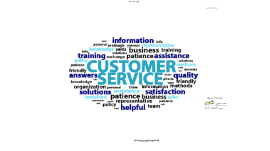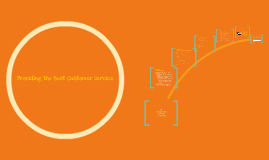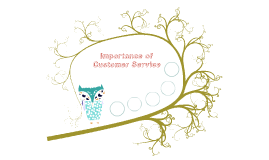Customer Service Presentation
Transcript: Practice, Practice Practice...Role-Playing! Who is Responsible for Customer Service? Interests and hobbies Occupation Education Cultural diversity Technology skills Location or community Access point: online, in-house, Affiliates, outreach To provide a basic introduction and understanding of the concepts of customer service. To give examples of good customer service, and how to achieve it. To explore the different aspects of good customer service (staff, facilities, collections and programs). To enpower staff to make the best customer service decision for each individual and each circumstance. To provide coping techniques for staff encountering the confused, dissatisfied and angry customer. To learn from and help each other. How to deal, cope and have each other's back! Angry Customers = Angry Staff? Questions? Handling Stress Navigating the Customer Service Experience SAY "what I can do is," INSTEAD OF "I can't." SAY "Yes, and," INSTEAD OF "Yes, but." SAY "Let's see if I can find out," INSTEAD OF "I don't know." SAY "Here's a list of organizations that may be able to help you," INSTEAD OF "We can't do that." SAY "You may want to look at the information I have," INSTEAD OF "You are wrong." SAY "I don't have the expertise to give you advice on that subject, but I can find you information," INSTEAD OF "I can't give advice." Create... Escape clauses in rules and policies. This is the Captain Jack Sparrow principle: "They're more like guidelines, really." You Are Here Pick up the phone ASAP, but don't pick it up just to stop the ringing, and continue your conversation with someone else. Say your name and identify your library. Remember to smile when you're speaking. Callers can "hear" the smile in your voice. Speak clearly and not too fast. If you have to put the customer on hold, ask if they can wait or would they rather call back. If you have to take the customer's name and number, write it down legibly (that's my biggest issue!) and repeat it back to the customer for correctness. Customer Service and the Mentally Unstable Frontline Customer Service Who Are Our Customers? Anger is contagious. Remember, it probably has nothing to do with you! Anger is a secondary emotion. The annoyed, frustrated, grouchy and mad. They...have the wrong library; are in a hurry; just need to check their email or print one form; "but they told me I could!" Anger is in the body. The body reacts to "fight or flight." Blood leaves the brain, and thinking stops. Hopefully, by not allowing customers to draw you into their anger, they will see that you are trying to resolve the issue and will calm down. But...This doesn't always work and the customer leaves angry. The customer is NOT always right...but they do have the right to express their opinion. Just do the best you can and move on. Customer Service: Facilities, Collections and Programming Effective Communication GOALS! Discretion allows for assessing each situation as unique. Are there any circumstances where you might: Waive fines? Check-out materials without the library card? Extend computer time limits? Allow customer use of staff equipment? Enpowerment doesn't mean disregarding the policies of the Library or PINES. It does mean weighing the customer service benefit of "exceptions" to the policy, versus strictly following it. Knowledge Customer Service and Enpowered Staff The Angry Customer Stay calm and don't take it personally. Speak in a lower voice. Don't argue. Apologize for the situation: "I'm sorry if you feel that way;" "I'm sorry if you were given the wrong information." Focus on what can be done, instead of what can't be done. Use S.E.T. Support, Empathy, Truth Support: Use statements that begin with "I". "I want to help you" or "How can I help you?" Empathy: NOT pity, but awareness and validation of their feelings. "I see that you're angry and I understand that this is frustrating" or "I understand how you must feel." Truth: A realistic and honest assessment of the situation, NOT the person's subjective experience. "This is what I can do for you" or "Here are some of your options." Try to remember to use "Support" and "Empathy" before "Truth", or the customer may become even more angry. Performance. Do customers always get correct information from the library? Availability. Can we put the latest bestseller in a customer's hands? Ease of use. Is it easier to search the library's catalog or Amazon.com for a book? Reliability. Can we perform the promised service dependably and accurately? Responsiveness. Are we willing to provide prompt and courteous service, with a smile? Empathy. Do we care about their needs and are willing to provided individualized service? The Angry Customer Children Young adults Homeschoolers Adults, including Seniors Businesses Ethnic populations Disadvantaged populations College students (26,000 at GSU alone!) Everyone! It happens in every part of library operations. In every service provided by the library. With external customers (library

















